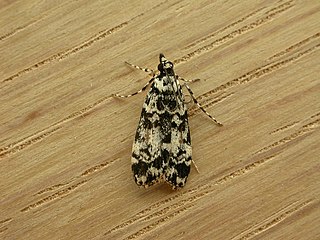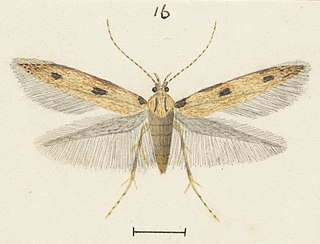
Eudonia aphrodes is a species of moth of the family Crambidae described by Edward Meyrick in 1884. It is found in Australia, where it has been recorded from New South Wales.

Zealandopterix zonodoxa is a moth of the family Micropterigidae. It endemic to New Zealand and is found from the Hawkes Bay north as well as on Poor Knights, Little Barrier and Great Barrier Islands. It is the smallest micropterigid in New Zealand and the shiny white markings on the forewing of this species are variable. It is a day flying moth, but has been collected using UV light. Adults are on the wing from September to March and the species has been witnessed visiting the flowers of Nikau and Cordyline pumilio in large numbers. It inhabits a wide variety of moist indigenous forest but is associated with forests in which podocarps are common. Larvae have been sieved from rotten wood on the floor of a mixed podocarp/broadleaf forest or extracted from moss or from bryophytes.

Labdia anarithma is a moth of the family Cosmopterigidae. It was described by Edward Meyrick in 1888. It is found in New Zealand and throughout Australia. Adults are on the wing from December to March and are day flying. They have been collected by sweeping bracken fern.

Gadira petraula is a species of moth in the family Crambidae. This species is endemic to New Zealand. It is classified as "At Risk, Naturally Uncommon" by the Department of Conservation. The 2010 and 2011 Christchurch earthquakes destroyed much of the habitat of this species.
Pyrgotis zygiana is a species of moth of the family Tortricidae. It is endemic to New Zealand.

Eudonia cymatias is a moth in the family Crambidae. It was named by Meyrick in 1884. This species is endemic to New Zealand.
Eudonia epicryma is a moth in the family Crambidae. It was described by Edward Meyrick in 1885. It is found in Australia, where it has been recorded from South Australia.
Eudonia homala is a moth in the family Crambidae. It was described by Edward Meyrick in 1885. It is found in Australia, where it has been recorded from South Australia.
Eudonia perierga is a moth in the family Crambidae. It was described by Edward Meyrick in 1885. It is found in Australia, where it has been recorded from Tasmania.
Eudonia synapta is a moth in the family Crambidae. It was described by Edward Meyrick in 1885. It is found in New Zealand and Australia.
Eudonia threnodes is a moth in the family Crambidae. It was described by Edward Meyrick in 1887. It is found in Australia, where it has been recorded from Western Australia.
Scoparia acropola is a moth in the family Crambidae. It was described by Edward Meyrick in 1885. It is found in Australia, where it has been recorded from Tasmania.
Scoparia anaplecta is a moth in the family Crambidae. It was described by Edward Meyrick in 1885. It is found in Australia, where it has been recorded from Tasmania.
Scoparia chiasta is a moth in the family Crambidae. It was described by Edward Meyrick in 1885. It is found in Australia, where it has been recorded from New South Wales.

Scoparia favilliferella is a moth in the family Crambidae. It was described by Francis Walker in 1866. It is found in Australia, where it has been recorded from Tasmania.
Scoparia gomphota is a moth in the family Crambidae. It was described by Edward Meyrick in 1885. It is found in Australia, where it has been recorded from Tasmania.
Scoparia philonephes is a moth in the family Crambidae. It is found in Australia, where it has been recorded from Victoria and South Australia.
Scoparia syntaracta is a moth in the family Crambidae. It was described by Edward Meyrick in 1885. It is found in Australia, where it has been recorded from New South Wales, Victoria, South Australia and Tasmania.
Scoparia tristicta is a moth in the genus Scoparia and the family Crambidae. It was described by Alfred Jefferis Turner in 1922. It is found in Australia, where it has been recorded from New South Wales.
Scoparia tritocirrha is a moth in the family Crambidae. It was described by Alfred Jefferis Turner in 1918. It is found in Australia, where it has been recorded from Norfolk Island.





